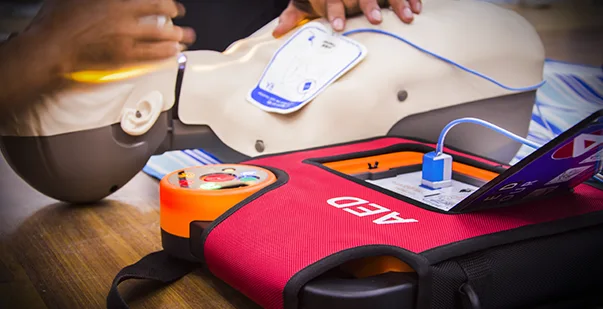Table of Content
- Introduction
- Sudden Cardiac Arrest and AED – An Overview
- Can you use AED on an infant?
- How to Use AED on Infants?
- Key Considerations for Infant AEDs
- Possible Complications of Using AED on Infants
- When do you use an AED on an infant?
- Equip Yourself to Act Effectively in Emergencies
Do you know sudden cardiac arrest (SCA) can even affect infants? SCA doesn’t discriminate and affects people of all ages. Administering timely CPR and AED (Automated External Defibrillator) within three to five minutes of cardiac arrest can prevent life-threatening situations.
It is therefore important to understand the differences when using an AED on infants, which greatly varies from the use in adults. As an AED supplies an electrical shock to the heart, most people are concerned about using the device on infants.
This blog will walk you through every aspect of using AEDs in infants to help you act confidently in such emergencies.
Master PALS Now
Get PALS certified with confidence
Sudden Cardiac Arrest and AED – An Overview
Before you decide if you can use an AED on an infant, it’s important to know about the incidences of cardiac emergencies in young children. Sudden Cardiac Arrest is relatively uncommon in infants. However, it can affect anyone, even those with ideal physical health. Each year, SCA affects the lives of children and adults in the U.S. It is also responsible for 10-15% of unexpected deaths of infants.
It’s not surprising that one of the common questions people hear is, ‘Can you use an AED on an infant? Now, before we answer that, it is important to know what causes sudden cardiac arrest in infants. Let us explore some possible reasons:
- Hypertrophic Cardiomyopathy (HCM): It is an inherited condition in which the heart muscles become enlarged, thickening the ventricle walls.
- Congenital Abnormalities: Some infants are born with abnormal heart arteries that might become compressed during exercise, reducing blood flow to the heart. Conditions include Long QT syndrome, atrial septal defects, ventricular septal defects, and Ebstein anomaly.
- Common Cordis – It is a rare cause of sudden cardiac death due to a blunt blow to the chest, often affecting young athletes and, in rare cases, fetuses in the womb.
Can you use AED on infants?
In a word, the answer is yes! AEDs (Automated External Defibrillators) are safe to use on infants. Providing prompt CPR and using an AED is an ideal way to treat an infant (anyone below the age of 1) in SCA (Sudden cardiac arrest). Usually, a manual defibrillator is preferred for infants. If it’s not available, you can use an AED to implement the life-saving technique. AEDs are usually designed with adults in mind, but they have pediatric settings and pads to adjust the energy level used, making them safe for infants.
Without effective treatment to restart the heart, that condition might develop into a life-threatening condition within minutes. Moreover, since infants have such small and delicate systems, it is even more important to get their hearts re-functioning quickly. This will restore the flow of oxygenated blood throughout the body, supplying the brain and other essential systems while limiting any further damage.
Read More: AED Use on Children and Infants
How to Use an AED on an Infant?
AEDs are imperative in life-threatening moments of cardiac arrest. Now that you know how an AED can be used on an infant, we will discuss the specific steps to use the device safely. However, it is also important to learn how to use the device correctly on an infant. Here’s the step-by-step guide for using an AED on an infant.
Step 1 – Active the AED
Most AEDs (Automated External Defibrillators) are designed to turn on automatically. If it doesn’t turn on automatically, turn it on manually and follow the visual instructions for the voice prompts.
Step 2 – Expose the Infant’s Chest
Before attaching the pediatric pads, remove any clothing or accessories that might be present on the infant’s chest. This will help you ensure that the pads are free of objects and that you have full contact with the skin. Also, ensure that you wipe the chest dry.
Step 3 – Apply Pediatric-Specific Pads
If available, you can use pediatric-specific pads specially designed for infants. If no specific pads are available, make sure to turn the AED device into infant/ child mode. You can follow the manufacturer’s instructions for proper pad placements. This typically involves carefully placing one AED pad on the center of the infant’s chest, just below the nipples, and another pad on the back.
Analyze the Heart Rhythm
Once the pads are properly placed, ensure no one is in contact with the infant. Now press the ‘analysis’ button on the AED and allow the device to analyze the infant’s heart rhythm.
- Deliver shock if indicated: If the AED advises delivering an electric shock as per the analysis, ensure everyone is clear from the infant and press the shock button as instructed. Follow the device’s guidelines and ensure everyone’s safety during the process.
- If the shock is not indicated: If the AED device doesn’t show any indication, administer CPR every 2 minutes and recheck the rhythm.
Resume CPR
After delivering the electric shock, immediately begin/ resume CPR with a ratio of 30 compressions to 2 rescue breaths. Remember to use only 2 fingers for the chest compressions. Repeat the cycle until the infant shows any signs of breathing/ recovery or until the EMT arrives at the scenario.
Read More: Can You Use Pediatric/Child AED Pads on an Adult?
Key Considerations for Infant AED Device
Infant AEDs (Automated External Defibrillators) have unique considerations that should be taken into account due to the physical traits of infants when compared to adults. Here are some features to look out for in the device:
- Energy Levels: Infant AEDs are built to deliver lower shock levels than adult devices. This is because infants have smaller bodies and require less energy for defibrillation. The energy level can be adjusted to ensure the safety of the infant during the process.
- Pediatric-specific pads: Pediatric pads are typically designed for infants under 1 year old and suit the smaller chest size and weight. These pads ensure proper adhesion and shock delivery to the infants. They might also have visual illustrations or markings to guide proper pad placements.
- Adaptable settings: Some AED devices have adaptable settings or modes that can be altered to use on infants. These settings include various parameters like energy levels and algorithms that adapt to the unique physiological condition of the infants to deliver optimal treatments.
- Visual and Audio Prompts: Infant AEDs typically offer visual and audio prompts customized to infant resuscitation. The voice institutions and visual images in the guide will walk you through the necessary steps of proper intervention.
- Compact size: Infant AEDs are designed in smaller sizes and are lightweight, making them easier to transport and handle during pediatric emergencies. The compact size also enables better maneuverability and application at critical moments.
Possible Complications of Using AED on Infants
The use of AED is generally safe and proven to be effective in treating cardiac emergencies in infants. However, a few side effects can arise that are relatively rare. They include:
- Skin Irritation or Burns: Prolonged contact with the adhesive electrodes used in infant AEDs might cause skin irritation or burns. To reduce the risk of skin-related complications, ensure proper placements and regular monitoring of the electrodes.
- Misinterpretation of Rhythm: The device analyzes the infant’s heart’s rhythm and determines if shock delivery is required. It prevents any misinterpretation or inaccurate assessment of the infant’s need for defibrillation.
- Interruption of CPR: When you use an AED on infants, there might be a brief interruption of cardiopulmonary resuscitation (CPR) when the shock is delivered. It is important to resume CPR immediately to ensure proper circulation and oxygenation.
- Inappropriate Energy Level: If an AED without pediatric-specific settings or child pads is used, it risks delivering an excess energy level that may be too high for a child’s smaller physique. This can potentially harm their health. Therefore, using the AED-size pads with modified placement techniques will aid in mitigating the risk during an emergency.
When do you use an AED on an infant?
An AED can be used on infants when they experience cardiac arrest or life-threatening arrhythmia. There are some other scenarios that might indicate the use of infant AED. These include:
- Respiratory distress – Severe respiratory distress in infants might lead to cardiac arrest. In such cases, you can use AED on infants to provide prompt defibrillation.
- Congenital heart condition – Infants with diagnosed or suspected congenital heart conditions may be at higher risk of experiencing cardiac emergencies. An AED should be readily available, to be utilized if needed.
- Post-Operative Cardiac Events – Infants who have undergone any cardiac surgeries or intentions may experience postoperative complications, which might lead to a heart attack. An infant AED should be accessible in such cases to ensure immediate intervention.
Equip Yourself to Act Effectively in Emergencies
Can you use an AED on an infant? The answer is yes. However, certain factors must be considered to ensure effective and safe usage. Due to their delicate bodies, it is appropriate to use pediatric-specific AED pads or an adaption to assure proper adherence and delivery of electric shocks.
Enrolling in proper AED infant training will equip you with the skills and knowledge to respond confidently to pediatric cardiac emergencies.
Remember, when you witness someone suffering from sudden cardiac arrest, call emergency services, start performing CPR, and use an AED as soon as it is available. It will give an infant, child, or even an adult the absolute best chances of survival.







